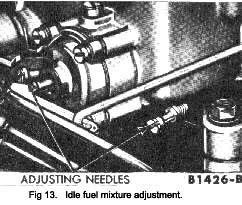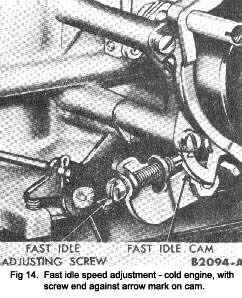
previously removed, remove them from the car-burettor.
2. Loosen the thermostatic spring housing clamp retaining screws. Set the spring housing to the specified index mark (Fig. 12) and tighten the clamp retaining screws.
3. Install the heater hose and bracket on the carburettor and tighten the bracket retaining screws. If other carburettor adjustments are not required, install the carburettor air cleaner assembly.
Idle fuel mixture and idle speed adjustments
The engine idle speed is adjusted to settings for a hot engine, and a cold (fast idle speed) during choke operation. With the air cleaner removed, make the idle adjustments in the following sequence.
If necessary, initially set the idle mixture by turning the Idle mixture screws (needles) inward (clockwise) until lightly seated then, turn the screws outward (counter-clockwise) 1-11/2 turns (Fig. 13). Do not turn the needles tightly against their seats as this may groove the ends. If the needle(s) is damaged it must be replaced before a satisfactory fuel mixture can be obtained.
1. Operate the engine for 30 minutes at 1200. r.p.m. to stabilize engine temperatures.
2. Set the parking brake. Attach a tachometer to the engine.
3. On a car with a manual shift transmission, the engine idle speed is checked and adjusted with the transmission selector lever in the neutral position. On a car with an automatic transmission, the engine idle speed is checked and adjusted with the transmission selector lever in the drive range position.
Place the transmission selector lever in neutral position on a car with a manual-shift transmission, or in drive range on a car with an automatic transmission.
|
Check the engine idle speed. Adjust the engine idle speed by turning the engine idle speed adjustment screw (Fig. 15) inward (clockwise) to increase the speed or outward (counterclockwise) to decrease the speed. When performing this adjustment, be sure the anti-stall dashpot (if fitted) is not interfering with the throttle lever or the fast idle adjusting screw is not contacting the fast idle cam.
4. Turn each idle mixture screw (needle) inward (Fig. 13) until the engine r.p.m. begins to drop from the lean mixture and turn each needle outward until engine r.p.m. increases and begins to drop from the rich mixture. Turn the needles inward for maximum engine r.p.m. and smoothness. The needles should be turned approximately the same amount. The final setting may vary approximately j turn difference between needles.
5. After the correct engine idle fuel mixture has been obtained, it is necessary to check the idle speed. Manually open and close the throttle. Check the engine idle speed and adjust, if necessary.
Final engine idle speed should be standard trans-mission 575/600 r.p.m., automatic transmission 475/500 r.p.m. in “ D”.
Cold fast idle speed
The adjusting screw on the right side of the carburettor
(Fig. l4) contacts one edge of the fast idle cam. The

|
 **
**

